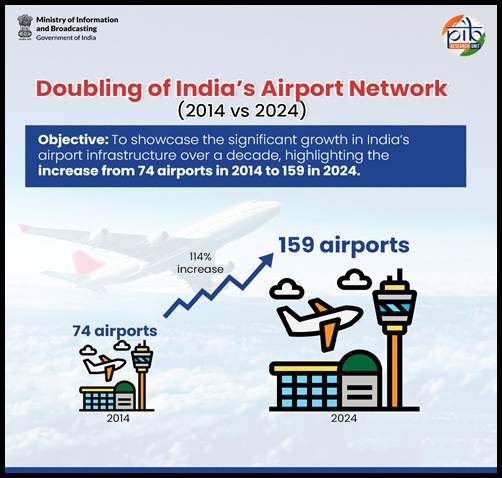World Air Transport Statistics (WATS) 2024

- 08 Aug 2025
In News:
According to the World Air Transport Statistics (WATS) 2024, released by the International Air Transport Association (IATA), India has emerged as the world’s 5th-largest aviation market, handling 211 million passengers in 2024.
Key Findings of WATS 2024
- India: 211 million passengers in 2024, growing 11.1% over 2023.
- Ahead of: Japan (205 million, 18.6% growth).
- Global Rankings:
- United States – 876 million passengers (+5.2%).
- China – 741 million passengers (+18.7%).
- United Kingdom – 261 million passengers.
- Spain – 241 million passengers.
- India – 211 million passengers.
- Busiest Routes (Airport Pairs):
- Global:Jeju–Seoul (South Korea) – 13.2 million passengers.
- India: Mumbai–Delhi – 5.9 million passengers, ranked 7th globally.
- Trend: Asia-Pacific dominated busiest airport-pair rankings.
India’s Aviation Transformation
1. Legislative Reforms
- Protection of Interests in Aircraft Objects Bill, 2025: Aligns leasing system with the Cape Town Convention, lowering leasing costs and boosting investor confidence.
- BharatiyaVayuyanAdhiniyam, 2024: Replaces colonial-era Aircraft Act, 1934; promotes Make in India, simplifies licensing, and aligns with ICAO norms.
2. Infrastructure Expansion
- New Terminals: Foundation laid at Varanasi, Agra, Darbhanga, Bagdogra.
- Greenfield Airports: 12 operationalised since 2014 (e.g., Shirdi, Mopa, Shivamogga); Navi Mumbai and Noida (Jewar) to be operational by 2025–26.
- Investment: ?91,000 crore allocated under National Infrastructure Pipeline (NIP); ?82,600 crore already spent by Nov 2024.
3. Government Initiatives
- UDAN Scheme: Expands regional air connectivity, affordable travel.
- National Civil Aviation Policy (NCAP): Boosts MRO (Maintenance, Repair, Overhaul), airport development, and leasing ecosystem.
- Green Airports Policy: Promotes renewable energy, waste reduction, and carbon neutrality.
- Aircraft Leasing Hub:GIFT City being developed as a global hub for aircraft leasing and financing.
Significance
- India consolidates its position as a major aviation hub, driven by rising passenger traffic, policy reforms, and infrastructure expansion.
- Reflects growing regional connectivity under UDAN and global competitiveness with regulatory modernisation.
- Places India in the top five global aviation markets for the first time.
